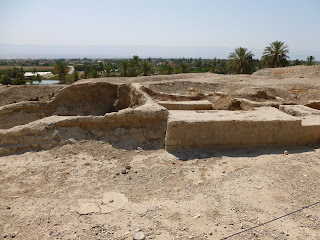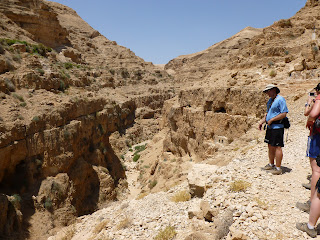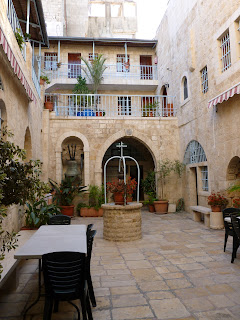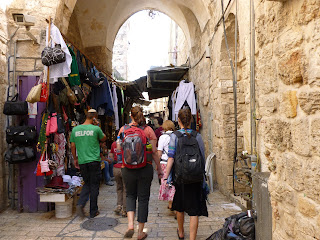Thursday, May 31, Jerusalem
I don't know if I've described some of the meals we've had (I'm now back in the states and finishing up this blog) but here are some pictures of our breakfast here in Bethlehem.

At the end closest to me you can see part of a pan of eggs with peppers and onions. There are trays of sliced cheese and bologna (I think - I never tried it) as well as yogurt. The yogurt was mixed with different things depending on the time of day it was served. In the morning it might be plane or have some fruit and typically at lunch or dinner it would have garlic mixed in.
Next are a couple of trays of humus. This is apparently 'the' side dish in the middle east. It was served at every meal and as a snack. I don't care for garbanzo beans and that is the basis of humus. I did try it to see if in its native home it was any better. Once was enough for me.
In this picture you can see my favorite dish - olives! Yes, we got to have olives for breakfast every day while at this hotel. For those who know me one of my basic food groups is salt and being blessed with low blood pressure I'm not afraid to consume my fair share of salty items. Besides, I was sweating out salt right and left on these hikes so I saw it as a valid medical necessity to have a spoonful or two to start the day.
The rest of the dishes were various salad items: shredded carrots, tomato and cucumber salad, marinated tomatoes, mixed salad, etc.
Finally at the end is a basket of pita bread - the other standard at each meal.
So breakfast for me was typically bread with cheese, some tomato salad, eggs, and olives.
Today was the first day we spent in the city of
Jerusalem. As usual there was a guard checkpoint we had
to go through to come from
Bethlehem in the West
Bank to get into
Jerusalem in
Israel proper. But even after getting into the city there
were security points for certain parts of the city (not too unlike some areas
in the US like major sporting events).
We started out by visiting the Temple Mount. This is an area at the top of Mount Moriah
where it is believed Abraham was prepared to sacrifice his son Isaac. Solomon built the Jewish Temple in 957 BC. It was destroyed in 586 BC and a second temple was built on the
same spot in 516 BC and that was destroyed in 70 AD by the Romans. Herod expanded the size of the Temple Mount
area by building giant retaining walls so he could have the second temple
expanded and restored in 16 BC. I’ll
leave it to you to research the further history of the mount but just summarize
that Muslims have controlled the Temple Mount since 1187 and it is revered in
that religion as the location of Mohammad’s journey to Jerusalem and ascent to
heaven making it the third holiest site in Islam.
We visited the top of the Mount and were able to photograph
the Dome of the Rock but not being Muslim we could not enter it. It is a magnificent building with beautiful
mosaic walls and a dome topped with gold leaf.
Beneath there is believed to be the rock of Abraham and Isaac and where
Mohammad stood.
This picture shows a little of the detailed mosaic work that surrounds the building and the marble used in the base.
There is also an ancient
mosque dating from the 15
th century.
This shows more of the Temple Mount area. It is a large area - having been expanded by Herod in order to expand the temple size. But this area would also have been full of pilgrims - especially during feast days.

Today since it is Muslim controlled and since it is uncertain exactly where the temple would have stood, Jewish people are forbidden by their religious leaders from going up on the temple mount. Instead they visit the Western Wall.
However, this small dome marks the spot where historians believe the Holy of Holies (place where the Ark of the Covenant would have resided and the place where God lived) stood at the time of the second temple.
The Jewish people still consider the western retaining wall of the
Temple Mount (called simply the Western Wall) a particularly holy site since it
is the closest part to where the Ark of the Covenant would have been kept in
the temple.
It is here that many people come to pray. The section behind the partition is where the men pray and the section closer to me is for the women. On Friday nights when the Jewish Sabbath starts this area is packed with people.
This is just part of the western wall which is still visible. Most of it continues past the wall you see in the background.
As we walked from place to place we were frequently coming across different excavated areas. Normally they built new buildings on top of these areas using pillars as a way to preserve the old but still build the newer needed buildings. It is fascinating to think of all the ancient ruins beneath this entire area - most of which will never be seen.
This is a section of colonnade pillars which would have lined the street and provided the store front for little shops all along the way.

Here is a picture (behind me in the picture above) of what it would have looked like.
 |
| Another section of columns outside |
A common practice is for Jewish families in America is to come to Jerusalem to celebrate the Bar Mitzvah (coming of age) of a son. There are companies which take care of all the arrangements including a band and someone to guide them through the ceremony. We frequently encountered these celebrations going on. In the distance you can see the family and relatives. The boy is under the canopy.
In the foreground are some of the military which were also always wandering the streets. We saw very few police officers but the military appear to have primary responsibility for patrolling the city. Everyone, men and women, serve 2 years in the military in Israel.
We visited one other place today where we could not take pictures. It was the
Temple Institute. They hold the controversial point of view that the temple should be rebuilt including re-instituting the practice of animal sacrifice. They have recreated many of the objects which would be used in the temple including robes for the high priests. They also believe that the ark of the covenant is buried in the temple mount - hidden in a chamber just before the first temple was destroyed. It was interesting to see the objects they have recreated and to hear more of the history of the temple but obviously there would need to be quite a drastic change in the political situations for any of this to take place but this is a place with a long and varied history already.
Over the years the area next to the western wall has been
built up and destroyed by various conquering peoples but in recent years they
have been excavating along the wall. We
toured through the tunnels which run along the side of the western wall which
is no longer visible above ground.
In the time of Jesus there was a raised walk way which lead from the area of the homes of the high priests directly to the top of the temple mount. Before they could enter the temple they had to perform their ritual cleansing routines and if they touched someone who had not done the same (and so was unclean) it would make them also unclean and they would need to again perform that routine. To cut down on the possibility of this, they built this shortcut which avoided the regular entrance to the temple mount. This picture is taken beneath one of the arches which held up that walkway.

It was common practice to simply build on top of the ruins left after the last conquering people moved through so you have layers of civilizations. As you can see from the picture above we were close to the underside of the arch which in the first century would have been high above the street. This is a picture looking down to what was the street running along the base of the western wall of the temple mount. The base of the column visible would have been one of the store front columns for shops along here. Because so many people would come to the temple to pray and need to buy not only animals for sacrifice but also day to day necessities these streets would have been as packed with little shops as are the current streets. Who knows, maybe even then there were some souvenir shops too. Undoubtedly Jesus and his parents would have walked along that road!

The wall itself is constructed of these massive limestone blocks, precisely cut and fitted into place and
then a beveled edge was chiseled into each one.
Every so many rows up they would set the block about 2 inches further
in, much the same way today’s retaining walls are constructed. It was amazing to touch these blocks that
were cut and set in place over 2000 years ago.
Here my thumb is on the lower block and you can see it sticks out an inch or two from the one on top. Just above my fingers is the beveled edge about 5 inches in from the edge of the stone. It sticks out about 1/2 inch. Notice how perfectly straight the edge of the stone as well as the bevel is! The people who cut these blocks had spent several years learning how to do this correctly so that the wall holding up their temple would be a perfect as possible. These were set in place without any cement to hold them. The quality and care is why this still stands today.
Section showing the tunnel we walked through along the wall.
Here you can see how later civilizations built walls and arches which butted up against the western wall.
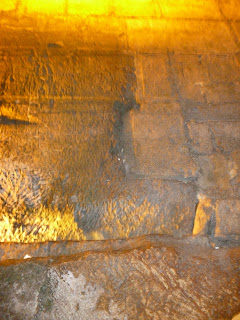
Because the temple mount is basically an area with retaining walls around it in order to provide a flat surface on which to build the temple, the walls eventually met up with the bedrock. Here in the center of the picture is where the two meet. They chiseled out the bedrock to provide a base for the rock wall.

In order to maintain the look of the wall they also chiseled the bedrock to match the pattern of the rest of the wall, including adding a beveled edge to make the solid rock look like blocks of granite. You can see that edge along the bottom of this picture.
We had some time over lunch to explore a little. In the old section of
Jerusalem (where we will primarily be
staying) the streets are narrow with shops all along them selling everything
from birds (canaries), spices, incense and brass to hookah pipes.
 |
| Man selling different types of incense |
 Later we traveled just outside the walls of old Jerusalem to David’s
City. This is where King David had his
palace.
Later we traveled just outside the walls of old Jerusalem to David’s
City. This is where King David had his
palace.
This picture is looking toward Jerusalem and the wall which surrounds the city, from the location of David's palace. It gives you a feel for the distance (not very much).
This is looking out over the area of David's City. I tend to think of cities in terms of what we have today with them being so big you need a car or other transportation to get from place to place. It is becoming obvious that cities 2000 years ago were pretty much the size of large neighborhoods today.
In about 700 BC when Hezikiah was king the city was under siege and in order to ensure water was available to
the city he ordered the construction of a tunnel which would divert the water
from the spring outside the city to a place within the city. The amazing thing is that they cut this
tunnel by hand for a distance of about ½ mile through solid granite. It has a .6% grade across its length and is
about 2 feet wide and from 4-7 foot tall.
Here is one of our group inside to give you a feel for the size of the tunnel they cut. This was solid granite!
They had 2 groups of people working from opposite ends and they managed to meet up nearly exactly at the right spot (had to dig about 3 feet in one direction to connect)! I know because you can walk through it.
I should say wade through it because water still flows through it
varying in depth from about 2 ½ feet to 8 inches. We each had small flashlights because it is completely dark inside. Some of our group is slightly claustrophobic so
to help them feel better we sang a variety of songs (amazing grace, Joy to the
World, and Row Row Row your Boat to name a few). It must have seemed like a good idea to the
group behind us because they started singing their own songs too but in a different
language.
At the end of the tunnel is the Pool of Siloam. When Jesus cured the blind man by making mud and putting it on his eyes, this is the pool he told the man to go to to wash off the mud and his sight was restored. That same pool remains today and we stopped to rinse our faces here too.

Finally to round out the day our bus driver Abu Ali (whom John has
used as his driver over the last 6 years) had invited us all to his home for
dinner.
I forget what it is called but the dish is cooked in a large bowl/pot (you can see the size of it in the middle). It is rice then chicken, more rice and vegetables with various spices all cooked together. Then you turn it out onto the tray and serve from that. The other bowls have different condiments, mostly yogurt based. It was wonderful!
He is Palestinian but was born
in
Israel so he can fairly
easily go from one part of
Israel
to another which has made him an especially useful driver for us. It is their custom that families across
generations will live together. He is
the oldest of 12 children so his parents live with him as do his 11 children,
the wives of 2 of his sons, and their 3 children. In all his mom has 75 grand and great grand
children! It was a wonderful meal and we
got a chance to learn more about him and his family. If only world relationships could be handled
on a more personal level like this.
There really would be world peace.
It is another late night and so I’m not getting a chance to
post any pictures with this (pictures are now posted). I do plan
to catch up but maybe not until Saturday or Sunday at this rate.



















